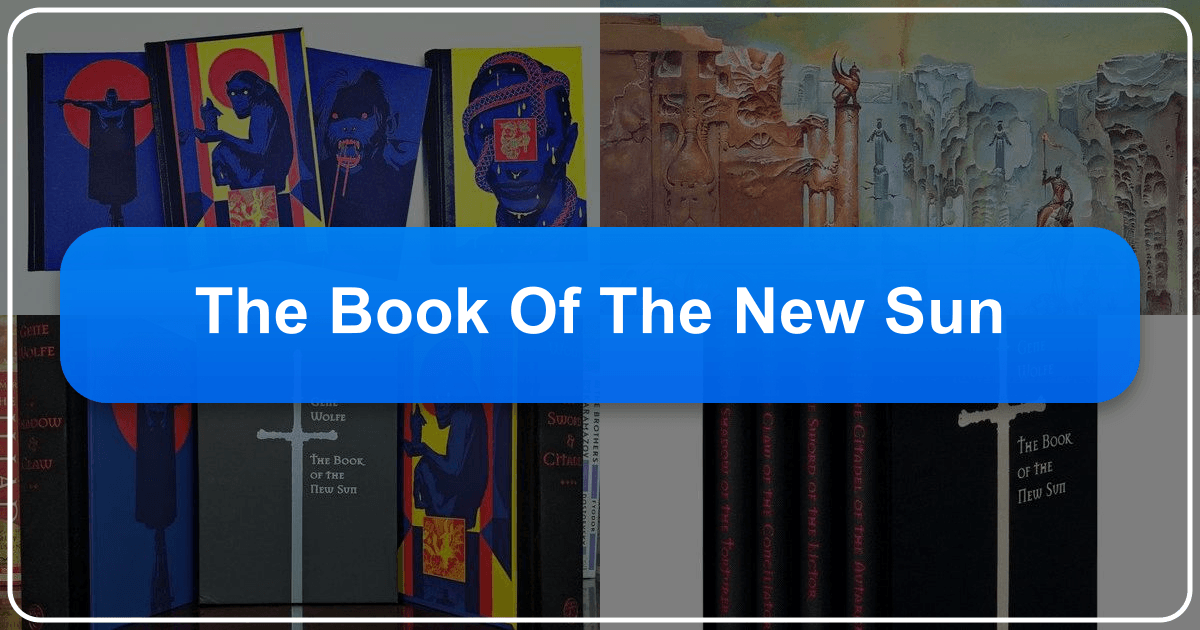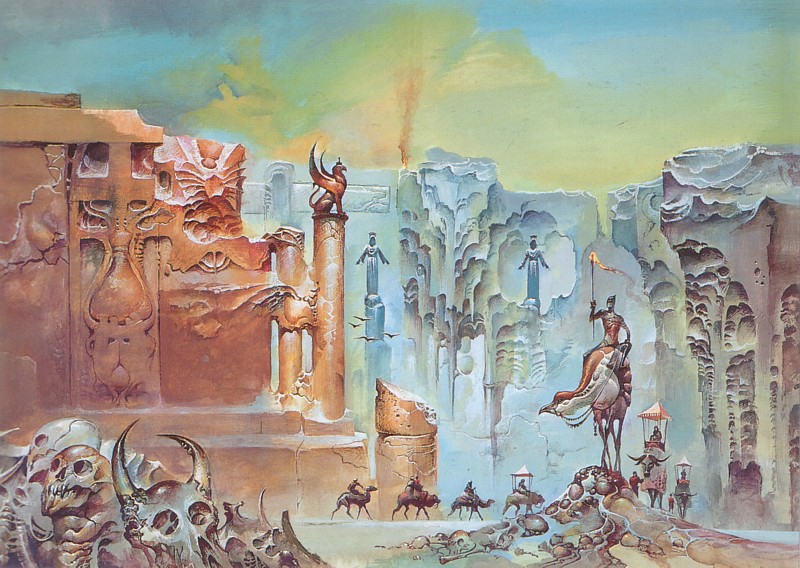The Book of the New Sun: A Deep Dive into Gene Wolfe's Masterpiece

Gene Wolfe’s The Book of the New Sun is not just a science fantasy novel; it’s a literary phenomenon, a sprawling epic that has captivated and challenged readers for decades. Its intricate plot, enigmatic prose, and multifaceted symbolism have solidified its place as a cornerstone of the genre, sparking countless critical analyses and interpretations. This exploration will delve into the various aspects of The Book of the New Sun, examining its place within the broader literary landscape, its enduring cultural impact, and the rich tapestry of themes it weaves.
The Book Itself: Genre, Style, and Structure
The Book of the New Sun is a four-volume science fantasy novel, often described as belonging to the “Dying Earth” subgenre. This subgenre, characterized by a far-future Earth in a state of decay and decline, finds its apotheosis in Wolfe’s work. Unlike typical Dying Earth stories, however, Wolfe’s vision is less about the literal decline of the planet and more about the decay of societal structures and the exploration of humanity’s capacity for both cruelty and compassion in a world where the sun itself is fading.

The four volumes—The Shadow of the Torturer, The Claw of the Conciliator, The Sword of the Lictor, and The Citadel of the Autarch—form a cohesive whole, a single narrative told from the perspective of Severian, a journeyman torturer. The story’s non-linear structure and ambiguous details challenge the reader to actively participate in constructing the story’s meaning, leading to multiple interpretations and making it a richly rewarding experience for those willing to dedicate the necessary time and focus. A fifth volume, The Urth of the New Sun, acts as a coda to the main story, further complicating and enriching the narrative’s complexity.
Wolfe’s writing style is unique and immediately noticeable; it incorporates archaic vocabulary, obscure allusions, and a deliberate ambiguity that enhances the novel’s mysterious atmosphere. He uses words rarely found in modern English, drawn from Latin and Greek roots, adding a sense of ancient wisdom and forgotten knowledge to the world he builds. This deliberate use of language forces the reader to actively engage with the text, slowing the pace and encouraging closer reading. It is precisely this complexity and layered nature that make The Book of the New Sun challenging yet uniquely rewarding.

The Ascian Language: A Tool of Control and Resistance
Wolfe’s skill in manipulating language extends beyond Severian’s narrative voice. The Ascian language, spoken in the northern totalitarian state of Ascia, is presented as a tool of social control, a system of carefully curated quotes from government propaganda that limits and dictates thought. However, Wolfe showcases how even such rigid language can be subverted, manipulated, and adapted by the Ascians themselves, demonstrating the innate human capacity to create meaning beyond the confines of imposed structure. This aspect of the novel comments on the power of language to both shape and resist oppression, adding a further layer of depth to the political and social commentary within the narrative.
Authorial Exploration: Gene Wolfe’s Life and Inspirations
Gene Wolfe’s background in engineering is evident in the intricate design of his fictional world. The Book of the New Sun is meticulously constructed, a testament to Wolfe’s precision and careful planning. Yet, Wolfe himself was a Catholic, and this is clearly reflected in the underlying religious symbolism which permeates the narrative. While Wolfe did not explicitly declare The Book of the New Sun to be an allegory for the life of Christ, the parallels between Severian and Jesus are undeniable.
Severian as a Christ Figure: Ambiguity and Interpretation

Severian, the protagonist and narrator, embodies many characteristics of a Christ figure. His journey is one of suffering, exile, and ultimate redemption. His profession as a torturer can be seen as a perverse parallel to Christ’s role as a carpenter, both working with wood to effect a different kind of transformation. Severian’s descent into the underworld, his raising of Dorcas, and even the recurring motif of bleeding from the forehead all echo the imagery and events of Christ’s life.
However, Wolfe’s approach is nuanced. He deliberately avoids a straightforward allegory, allowing Severian to remain a conflicted and complex figure, never fully embodying the idealized image of Christ. This ambiguity is essential to the novel’s depth, inviting multiple interpretations and leaving room for the reader’s own critical engagement. The religious themes within the narrative become thus a key element to engage with and understand the story, reflecting Wolfe’s personal beliefs and providing rich material for theological interpretation.
Related Works and Literary Context
The Book of the New Sun is not a standalone work; it’s the foundation of Wolfe’s larger “Solar Cycle,” a shared universe encompassing several novels and short stories. The series is also interwoven with numerous literary allusions and references, weaving together threads from classical literature, mythology, and other science fiction and fantasy texts. This connection to a broader literary tradition highlights Wolfe’s deep engagement with his source material and his unique ability to reimagine established tropes within a new and intriguing context.
The Solar Cycle: Expanding the Universe of Urth
The two subsequent series—The Book of the Long Sun and The Book of the Short Sun—expand upon the concepts and themes introduced in The Book of the New Sun, furthering the exploration of time, religion, and the nature of reality within this intricate universe. While distinct narratives, these later works resonate with the themes and stylistic elements of the original tetralogy, creating a rich and interconnected body of work. The short stories associated with the Solar Cycle further enrich and expand the context, offering glimpses into additional characters and perspectives within the setting.
Cultural Impact and Reception
The Book of the New Sun has garnered significant critical acclaim and has earned a place amongst the most celebrated and influential works of science fantasy. It has won numerous prestigious awards, including the World Fantasy Award and the Nebula Award, further solidifying its standing as a seminal text within speculative fiction. The influence of The Book of the New Sun extends far beyond the simple acquisition of awards, though. It has left a significant mark on both science fiction and fantasy. The work has inspired generations of authors, impacting the style and thematics within the broader speculative fiction landscape. The complexity and ambiguity of its narrative have influenced subsequent authors to incorporate similar elements into their own works.
Communities and Adaptations: The Enduring Legacy
The novel’s complex nature has also fostered a vibrant online community of readers and scholars dedicated to the analysis and interpretation of its intricate details. The ongoing debates and explorations surrounding the themes of The Book of the New Sun demonstrate its continuing relevance and enduring impact on the readers who engage with it. These communities, both online and in-person, have significantly contributed to the novel’s lasting legacy and have led to a richer understanding of its multifaceted complexities. While adaptations of the work remain rare, the novel’s significant cultural impact continues to inspire appreciation, discussion, and further artistic endeavor. Its influence on subsequent works of literature, its creation of a passionate fan-base, and its impact on the overall trajectory of speculative fiction are a testimony to its lasting value and merit.
In conclusion, The Book of the New Sun transcends the boundaries of genre, existing as a powerful exploration of fundamental human experiences, framed within a richly imagined and meticulously crafted world. It challenges the reader, demanding active participation and critical engagement, yet simultaneously rewards that effort with a unique and deeply satisfying narrative experience. Its lasting impact on the world of literature is undeniable, proving that Wolfe’s complex masterpiece continues to influence and inspire in the decades since its publication.